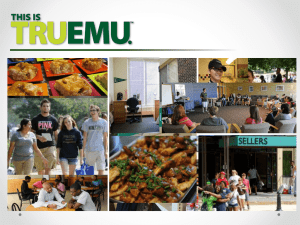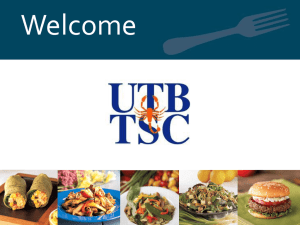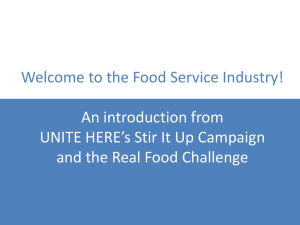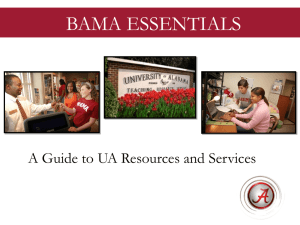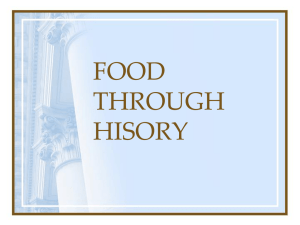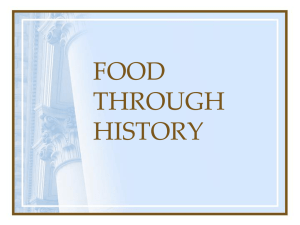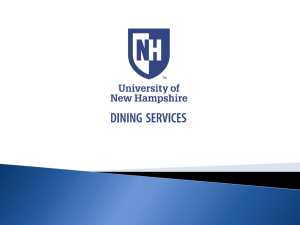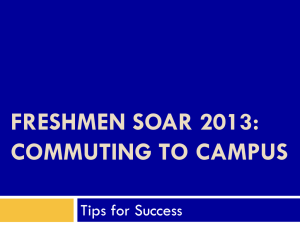how to create meaningful gathering places & grow
advertisement
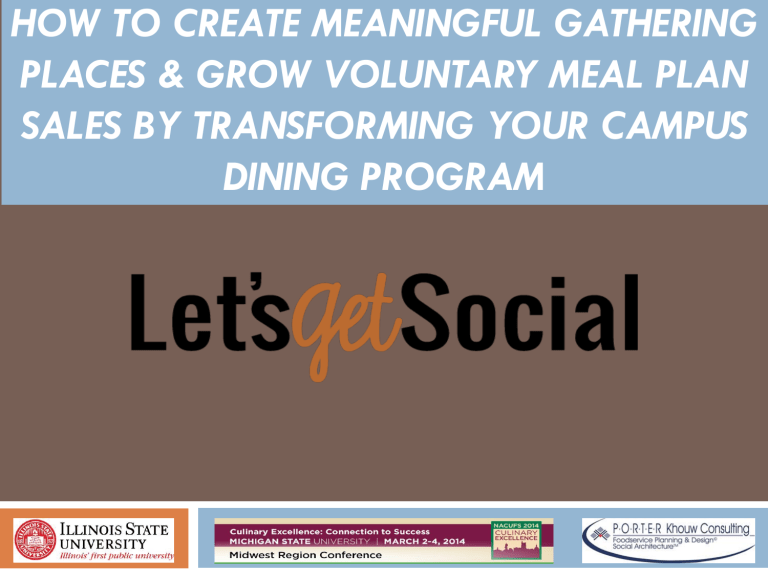
HOW TO CREATE MEANINGFUL GATHERING PLACES & GROW VOLUNTARY MEAL PLAN SALES BY TRANSFORMING YOUR CAMPUS DINING PROGRAM Your Hosts Arlene Hosea Assistant to the Vice President & Director of Campus Dining Illinois State University David Porter Author, President & CEO Porter Khouw Consulting, Inc. What Is Social Architecture ? TM Emotional Connections Gravitational Pull Toward dining venues Students & school Design Meaningful Social Connections Last a Lifetime Social Energy Universal Appeal Sense of Community Heartbeat/Living Room/Kitchen Compelling Benefits of Social ArchitectureTM Higher Recruitment Capture Rates Higher % Alumni Involvement Higher Retention Rates Higher GPAs Higher Quality Housing Higher Graduation Rates College & University….. Recruitment Yield Rates Retention Graduation Rates Make Campus More Sticky Alumni Housing Student Unions Recreation Centers Classroom Outside of the Classroom….. Socially Engage Study Plan Wholesome Social Flipping The Classroom Live & Dine On-Campus Face-to-Face Social Electronic Social Media Get A Good Job High Cost of Low Education Social ArchitectureTM Our Hunger for Love and Affirmation is Greater than our Hunger for Bread… Mother Teresa #3 Maslow’s Hierarchy of Needs To Socially Connect Did Facebook Create our Need to Connect to Others? If we keep fighting for our limitations, we will most likely get to keep them…… College & University Program Trends….. Lifestyle/Living Student Clock Portability Healthy Menu/Food Gluten Free Food Allergy Vegetarian Vegan Paleo Performance Dining College & University Program Trends….. Sustainability Facility – State of the Art….. Branding Farm to Fork Locally Grown Organic National, Regional, Self-Branding Meal Plans Catering Financial Due Diligence How To Determine the Optimum Dining Program Ask Yourself These Questions What is the optimum dining program for our unique campus? How do we organize dining in order to optimize social engagement? Do we need to enhance facilities? What will it cost? Seek Independent Insights With so much at stake, it's critical to use independent & objective experts to facilitate a proven process to design the optimum dining program. Determine Who You Are What makes your campus unique? Demographics Geography Culture Traditions Preferences Growth plans/enrollment Political environment Financial realities GOAL: To expand & enhance the student dining experience. Determine Who You Are Ask these questions: What is your retention rate? What is your missed meal factor? Is meal plan participation up or down? Are the meal plans a good value or not? Can students use their meal plans when they want to? Is there a lack of social connectivity on campus? Does the program attract or subtract from student life on campus? Market Research Market Research Market Research Interview students & stakeholders. Directors of admissions, housing, res life and advancement (retention & recruitment) Residential & commuter students Faculty & staff Catering customers & conference planners Campus administrators Determine customers’ perceptions regarding: Hours of operation Monday-Friday & Saturday and Sunday Menu variety Meal plans Methods of service Locations Ambiance Speed of service Customer service Market Research Survey the campus community including students, faculty & staff. Where are customers eating off campus/calling for delivery? What time of day/night? How do they pay for purchases? What they do now is a better indication of what they will do. Use market research determine where the program is lacking & where opportunities lie. Market Research Evaluate your facilities. Do they meet today’s standards or are they in a time warp? Are they competitive with your cross applicant schools? How much deferred maintenance exists? Optimum Dining Program Develop the optimum dining program for YOUR campus. Elements should include: Concepts Brands Hours (Monday-Friday & weekends) Menu variety Meal plans Methods of service Methods of payment Locations Ambiance Speed of service Customer service Optimum Dining Program Financial consequences How will meal plan participation change? How much more labor will you need or how can the current labor be better utilized? Can you reduce labor? If you open new locations, how many operating days will they be open and what will the average check be? How will your operating expenses change? How much can you anticipate growing your bottom line in a five-year period? Optimum Dining Program Identify necessary facility changes. Facilities should be designed to functionally support the optimum dining program. Do the current spaces need to be enlarged or redesigned to ensure easy customer throughput & the ability to provide topnotch service? How many customers does each facility need to support at the peak meal period? Will this change in the future? How much will it cost to make changes? Before After Value Proposition Access Driven: Anytime Dining Promotes less food waste/consumption Provides ultimate in flexibility Appeals to parents/easy transition from home No leftover meals Higher gross profitability Lower food cost (21-28%) Voluntary meal plan participation increases Consumption Driven: Meals Per Week/Semester Promotes food waste Unnecessary spending Less gross profitability Meals must generally be consumed during certain time periods Leftover meals/dining dollars causes dissatisfaction Does not appeal to parents Areas to Consider When Thinking Ahead How & in what venues will customers be able to use meal plan money? How do current staffing schedules need to be modified to meet customer demand & extended hours of operation? What menu offerings are going to be available in each venue? What kind of equipment layout/utilities will be needed? What changes to the campus landscape (new building, new arteries through campus) could impact the success of the dining program? Are our current facilities undersized & how large do they need to be to accommodate any changes in enrollment? What impact will these proposed changes have on your department’s bottom line? Creating a campus-wide dining services master plan will help answer these questions! A New Vision for Dining at Illinois State University Illinois State Campus Dining At A Glance Public four-year university Enrollment: 21,000 Self-operated dining department Department includes: 2 residential dining commons Watterson Dining Commons: Renovated in 2010 Marketplace at Linkins Center Multiple retail locations around campus & in the Bone Student Center Catering Central bakery Total annual revenue: $31 million #of meal plan holders: 7,585 # of residential students: 6,400 Before After Case Study – Illinois State PKC was retained by ISU in 2004 to develop long-term campus wide strategic master plan for CDS. Recommendations included customer-friendly, value-added anytime dining meal plans, extended hours of operation and other significant program enhancements. Planning project resulted in a design initiative to renovate Linkins Dining Center. The study also included a review of the feasibility of central production. PKC prepared extensive financial models, staffing matrices and developed a payback analysis (ROI) for proposed foodservice venues and reviewed current business systems. The Results When ISU introduced the new changes to the dining program (after pushback from students & marketing efforts by CDS to explain the benefits of the new program), the then student-body president said: “The meal plan options now fit every student’s lifestyle and needs, whether they are on campus, off campus or commute. It’s great to be able to find a meal plan that fits me. With the addition of off-campus meal plans, it allows those students to once again enjoy a great dining experience with convenience of being right on campus.” The Results Since CDS implemented PKC’s recommendations, they have increased the number of off-campus meal plan sales (from fewer than 200 in 2005 to more than 1,200 in 2010 and more than 3,000 in 2013*). At new off-campus apartment complex, 2/3rds of student residents purchased meal plans in 2013. Customer satisfaction is high. Increased participation among faculty and staff who now eat in the residential dining venues again. The social architecture on campus has been strengthened by creating meaningful dining/learning commons on campus to provide safe and inviting places for students to gather. ISU Customer-based Meal Plans Unlimited Access Meal Plans: 7-Day Unlimited (unlimited access to any residential dining center, seven days a week) plus $265 Flex Dollars/semester. Cost: $2,236 5-Day Unlimited (unlimited access to any residential center, Monday-Friday only) plus $340 Flex Dollars/semester. Cost: $2,067 Traditional Access Meal Plans: 19-Meal Traditional (access to any 19 meals per week – unused meals expire each Sunday) plus $436 Flex Dollars/semester. Cost: $2,344 14 Meal Traditional (access to any 15 meals per week – unused meals expire on Sunday) plus $485 Flex Dollars/semester. Cost: $2,158 Block 225 Meal Plan: 225 Block Meals (access to any 225 meals throughout the entire semester) plus $339 Flex Dollars/semester. Cost: $2,051 Methods of Payment Meal plan money/unlimited access Flex Dollars Cash Credit/debit cards Anytime Dining in Residential Dining Centers Unlimited access featuring unlimited seconds & made-to-order food seven days a week at Watterson Dining Commons & The Marketplace at Linkins Center. Hours of operation: M-Th: 7 a.m. -10 p.m., Fri.: 7 a.m. to 8 p.m. Sat.: 9 a.m. to 8 p.m., Sun.: 9 a.m. to 10 p.m. Expanded menu variety to improve customer satisfaction. These venues are now functioning as dining/learning commons & provide meaningful, safe and wholesome social gathering places for all campus community. The DNA of a Successful Anytime Dining Program Anytime Dining Meal Plans Continuous Hours of Operation Extended Hours of Operation Menu Variety & Selection State-of-the-art Facilities Retail Approach Optimum Value ISU’s Thriving Campus Dining Program Meal Plan Counts Fall 2008 Traditional Residence Hall 5897 Fall 2009 6457 Fall 2010 6378 Fall 2011 6337 Cardinal Court Off-Campus Total Meal Plan Counts Fall 2012* Fall 2013 5146 4828 725 743 751 804 1200 1797 1997 2337 6648 7261 7578 8134 7868 7908 ISU’s Thriving Campus Dining Program “The Future” Other program enhancements: Dining Services Advisory Council Changes planned for Fall 2014: Renovation of Student Center Addition to Watterson: - Culinary Innovation Center Available on Amazon.com “David Porter is a leader in the transformation of dining in higher education. He and his dynamic team challenge their clients to think progressively and creatively….I was one of those clients. The work he has done in the area of meal plan design and development has helped universities grow their meal plans to rates that exceeded all expectations. We judge our success by how satisfied our students are with the dining program. At the end of the day, that is what truly matters on a college campus.” Arlene Hosea Assistant to the Vice President for Student Affairs and Director of Campus Dining Services, Illinois State University THANK YOU! Questions? david.porter@porterkhouwconsulting.com amhosea@ilstu.edu
